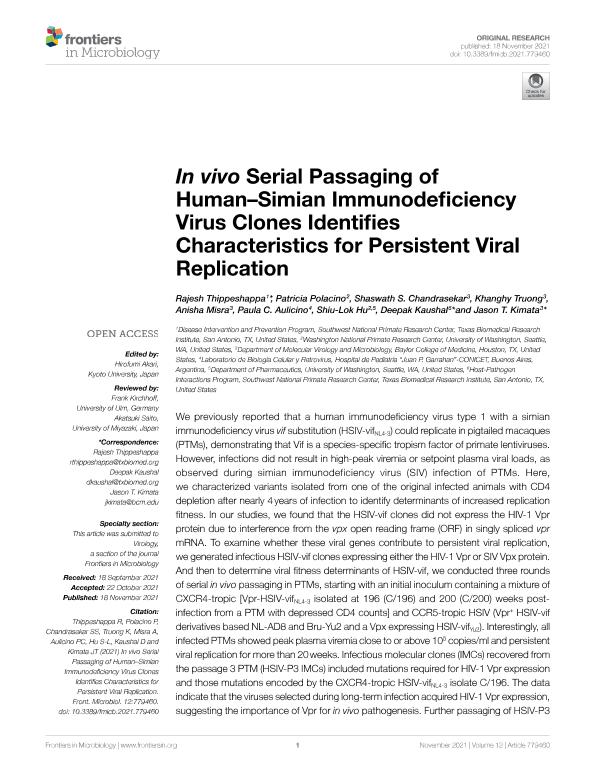Mostrar el registro sencillo del ítem
dc.contributor.author
Thippeshappa, Rajesh
dc.contributor.author
Polacino, Patricia
dc.contributor.author
Chandrasekar, Shaswath S.
dc.contributor.author
Truong, Khanghy
dc.contributor.author
Misra, Anisha
dc.contributor.author
Aulicino, Paula

dc.contributor.author
Hu, Shiu-Lok
dc.contributor.author
Kaushal, Deepak
dc.contributor.author
Kimata, Jason T.
dc.date.available
2022-08-24T17:29:07Z
dc.date.issued
2021-11
dc.identifier.citation
Thippeshappa, Rajesh; Polacino, Patricia; Chandrasekar, Shaswath S.; Truong, Khanghy; Misra, Anisha; et al.; In vivo serial passaging of human–simian immunodeficiency virus clones identifies characteristics for persistent viral replication; Frontiers Media; Frontiers in Microbiology; 12; 11-2021; 1-14
dc.identifier.issn
1664-302X
dc.identifier.uri
http://hdl.handle.net/11336/166462
dc.description.abstract
We previously reported that a human immunodeficiency virus type 1 with a simian immunodeficiency virus vif substitution (HSIV-vifNL4-3) could replicate in pigtailed macaques (PTMs), demonstrating that Vif is a species-specific tropism factor of primate lentiviruses. However, infections did not result in high-peak viremia or setpoint plasma viral loads, as observed during simian immunodeficiency virus (SIV) infection of PTMs. Here, we characterized variants isolated from one of the original infected animals with CD4 depletion after nearly 4years of infection to identify determinants of increased replication fitness. In our studies, we found that the HSIV-vif clones did not express the HIV-1 Vpr protein due to interference from the vpx open reading frame (ORF) in singly spliced vpr mRNA. To examine whether these viral genes contribute to persistent viral replication, we generated infectious HSIV-vif clones expressing either the HIV-1 Vpr or SIV Vpx protein. And then to determine viral fitness determinants of HSIV-vif, we conducted three rounds of serial in vivo passaging in PTMs, starting with an initial inoculum containing a mixture of CXCR4-tropic [Vpr-HSIV-vifNL4-3 isolated at 196 (C/196) and 200 (C/200) weeks post-infection from a PTM with depressed CD4 counts] and CCR5-tropic HSIV (Vpr+ HSIV-vif derivatives based NL-AD8 and Bru-Yu2 and a Vpx expressing HSIV-vifYu2). Interestingly, all infected PTMs showed peak plasma viremia close to or above 105 copies/ml and persistent viral replication for more than 20weeks. Infectious molecular clones (IMCs) recovered from the passage 3 PTM (HSIV-P3 IMCs) included mutations required for HIV-1 Vpr expression and those mutations encoded by the CXCR4-tropic HSIV-vifNL4-3 isolate C/196. The data indicate that the viruses selected during long-term infection acquired HIV-1 Vpr expression, suggesting the importance of Vpr for in vivo pathogenesis. Further passaging of HSIV-P3 IMCs in vivo may generate pathogenic variants with higher replication capacity, which will be a valuable resource as challenge virus in vaccine and cure studies.
dc.format
application/pdf
dc.language.iso
eng
dc.publisher
Frontiers Media

dc.rights
info:eu-repo/semantics/openAccess
dc.rights.uri
https://creativecommons.org/licenses/by/2.5/ar/
dc.subject
ANIMAL MODEL
dc.subject
HIV-1
dc.subject
HSIV-VIF
dc.subject
IN VIVO PASSAGING
dc.subject
INFECTIOUS MOLECULAR CLONES
dc.subject
NONHUMAN PRIMATES
dc.subject
PIGTAILED MACAQUES
dc.subject
SIV
dc.subject.classification
Enfermedades Infecciosas

dc.subject.classification
Ciencias de la Salud

dc.subject.classification
CIENCIAS MÉDICAS Y DE LA SALUD

dc.title
In vivo serial passaging of human–simian immunodeficiency virus clones identifies characteristics for persistent viral replication
dc.type
info:eu-repo/semantics/article
dc.type
info:ar-repo/semantics/artículo
dc.type
info:eu-repo/semantics/publishedVersion
dc.date.updated
2022-08-23T11:13:39Z
dc.journal.volume
12
dc.journal.pagination
1-14
dc.journal.pais
Suiza

dc.journal.ciudad
Lausana
dc.description.fil
Fil: Thippeshappa, Rajesh. Texas Biomedical Research Institute; Estados Unidos
dc.description.fil
Fil: Polacino, Patricia. University of Washington; Estados Unidos
dc.description.fil
Fil: Chandrasekar, Shaswath S.. Baylor College of Medicine; Estados Unidos
dc.description.fil
Fil: Truong, Khanghy. Baylor College of Medicine; Estados Unidos
dc.description.fil
Fil: Misra, Anisha. Baylor College of Medicine; Estados Unidos
dc.description.fil
Fil: Aulicino, Paula. Consejo Nacional de Investigaciones Científicas y Técnicas; Argentina. Gobierno de la Ciudad de Buenos Aires. Hospital de Pediatría "Juan P. Garrahan". Laboratorio de Biología Celular y Retrovirus; Argentina
dc.description.fil
Fil: Hu, Shiu-Lok. University of Washington; Estados Unidos
dc.description.fil
Fil: Kaushal, Deepak. Texas Biomedical Research Institute; Estados Unidos
dc.description.fil
Fil: Kimata, Jason T.. Baylor College of Medicine; Estados Unidos
dc.journal.title
Frontiers in Microbiology
dc.relation.alternativeid
info:eu-repo/semantics/altIdentifier/url/https://www.frontiersin.org/articles/10.3389/fmicb.2021.779460/full
dc.relation.alternativeid
info:eu-repo/semantics/altIdentifier/doi/http://dx.doi.org/10.3389/fmicb.2021.779460
Archivos asociados
